The Art of Research: Photo Gallery 2017 – 18
The Art of Research photo contest is an opportunity for Queen’s faculty, students, staff, and alumni to showcase their research, scholarly, and artistic work. The competition is aimed at providing a creative and accessible method of sharing and celebrating the ground-breaking research being done by current and past Queen’s community members.
Biomimetic Scaffolds
Fei Chen
The Anterior Cruciate Ligament (ACL) of the knee joint, one of the strongest ligaments of the body, is also the target of traumatic injuries. Once injured, its healing potential is limited. The ACL mainly consists of packed and thick collagen fibres oriented along the long axis in a wavy pattern, and this unique wavy pattern is essential for providing load-bearing protection to the knee joint. This SEM image shows a bioengineered fibrous scaffold made from synthetic biomaterials with a wavy pattern, with amplitudes and wavelengths similar to the collagen fibers present in a native ACL.
Location of photograph:
Dupuis Hall, Queen’s University
Affiliation:
Staff, Chemical Engineering
Submission Year:
2017-18

Unspooling Vermeer
Stephanie Dickey
Wherever I go, I look for evidence of how the historical art I study impacts visual culture today. In “After Vermeer 2,” an installation from 2006 by New York artist Devorah Sperber, 5024 spools of thread strung on steel chains recreate, upside down, the famous “Girl with a Pearl Earring” painted by Dutch artist Johannes Vermeer around 1665. My photo captures the viewer’s experience of looking through a glass sphere in which the image rights itself. Vermeer, whose paintings explored both optics and female experience, would surely have appreciated this perceptive transformation of his art.
Location of photograph:
Kimmel Center, Philadelphia, USA
Affiliation:
Faculty, Art History and Art Conservation
Submission Year:
2017-18
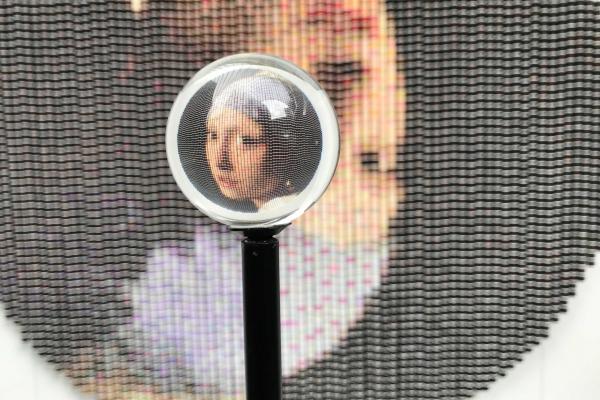
Landscapes of Resistance
Alexandra Pedersen
As a feminist/activist geographer, much of my doctoral research has concentrated on Indigenous and non-Indigenous communal experiences of violent development in Guatemala. An emblematic case of community conflict with, and resistance to, transnational corporate interests comes from the remote community of Lote Ocho. There, Irma Yolanda Choc Cac (pictured here) is one of eleven Indigenous Q’eqchi’ Maya women pursuing a civil court case against the Canadian mining company HudBay Minerals for sexual assaults allegedly committed during a violent eviction of her community from their ancestral lands in 2007.
Location of photograph:
Lote Ocho, Izabal, Guatemala
Affiliation:
PhD Student, Geography and Planning
Submission Year:
2017-18

Inside Concord Floral
Naseem Loloie
Under the heat of the lights, covered in a stranger’s clothes, surrounded by the sights and sounds of the stage – this is when the actor’s transformation comes to life. During Theatre Kingston’s production of Jordan Tannahill’s Concord Floral, the audience and actors are seated inside an abandoned greenhouse – or at least, a stage mimicking a greenhouse through set design by Sean Mulcahy and lighting by Jennifer Lennon. As both an actor and an assistant director in this production, Naseem’s research focuses on costume, lighting, set and staging, and their transformative effects on the actor’s experience as they become a character.
Location of photograph:
Isabel Bader Centre for the Performing Arts, Queen's University
Affiliation:
Undergraduate Student, Dan School of Drama and Music
Submission Year:
2017-18
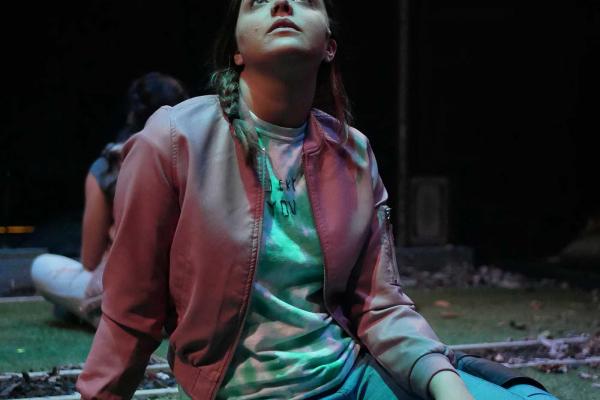
Platinum Surface Electrochemistry
Derek Esau
The single crystal of platinum gently hangs atop an electrolyte surface. Electrochemistry is a surface-sensitive field of research, as the composition and atomic arrangement of the electrode drastically affect its properties. Atoms in a single crystal are highly ordered, and we are able to cut and polish a crystal in such a way that we only expose one of the many possible surface arrangements. The single crystal electrode is balanced on the surface of the electrolyte to ensure that only the polished surface is exposed. These experiments give us fundamental information about electrochemical reactions, which are integral to the field of clean energy.
Location of photograph:
Department of Chemistry, Queen's University
Affiliation:
PhD Student, Chemistry
Submission Year:
2017-18
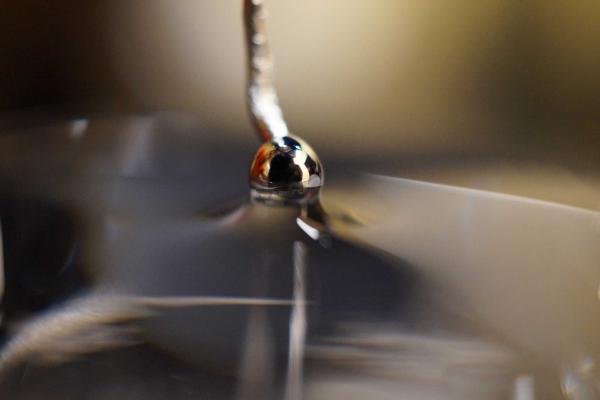
Exploring Worlds at Home
James Xie
The Queen's Space Engineering Team constructs a Mars rover each year to compete at the international University Rover Challenge in Utah. QSET brings together over 40 students from engineering, science, commerce, and the arts to design, build, and operate the rover. The rover can autonomously navigate treacherous landscapes, collect geological data, analyze samples, and remotely operate machinery. It can be seen here gazing out into the Utah desert. The rover is a culmination of countless hours of volunteer work and generous support from both Queen’s and industry partners. The team was proud to be the top team in Canada at the 2017 competition.
Location of photograph:
Mars Desert Research Station, Utah
Affiliation:
Undergraduate Student, Engineering Chemistry
Submission Year:
2017-18
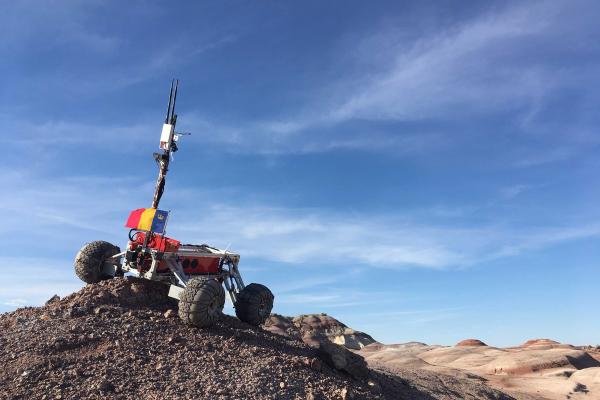
A Musical High Point
Tim Fort
In my thirtieth summer as a producing director at the Weston Playhouse in Vermont, we chose to open the season with the Tony Award winning musical “Once” – a show set in a Dublin pub in which the actors also serve as the musicians. In this moment, one of the actor-musicians became airborne doing his pre-show warm-up in front of the audience and cast.
Location of photograph:
Weston Playhouse, Vermont
Affiliation:
Faculty, Dan School of Drama and Music
Submission Year:
2017-18

Still-life painting alight with UV-radiation
Courtney Books
Art conservation uses Ultra-violet lighting in a similar way that a detective uses a black light to inspect a crime scene. Awash with the electromagnetic radiation, i.e. light in the form of wavelengths, the painting's secrets are revealed; artist materials fluoresce distinct colours in the visible spectrum depending on the age and type of material present. A conservator is able to approximate the age of a painting (e.g. the milky green-yellow glow of varnish intensifies with time) and discern what is original, artist applied material versus those subsequently added to the painting, such as a restorer or conservator's touch.
Location of photograph:
Madrid, Spain
Affiliation:
Graduate Student, Art History and Art Conservation
Submission Year:
2017-18
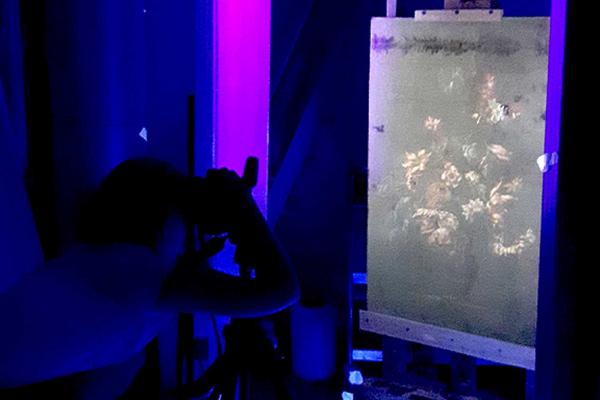
There is a highway in the lab?!
Dustin Brennan
A major innovation is happening in the structures laboratory at the Department of Civil Engineering at Queen’s University. The first ever Rolling Load Simulator – R●LS in Canada for testing highway bridges is making a big impact in the lab. This machine is capable of delivering tens of years’ worth of heavy truck loading, simulating the long service life of a highway bridge at full scale. Bridges are the ultimate expression of art and science in structural engineering. Results from further tests in this machine will advance our understanding of the complex behavior of bridges under realistic loading conditions.
Location of photograph:
Civil Engineering Department, Queen's University
Affiliation:
Graduate Student, Civil Engineering
Submission Year:
2017-18
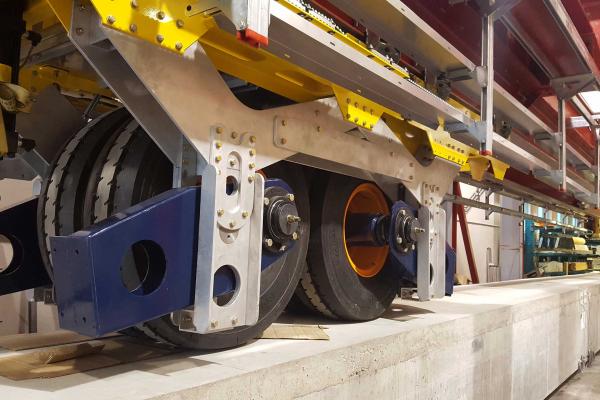
Artful Arterial Artificers
Jonah Burke-Kleinman
Unlocking the secrets of cells from a human artery, grown in culture. We can stain components of cells to study where and how they work! Blue stain is the cell nucleus (DAPI), red is actin (phalloidin). Green stain is a protein called PDE3B we study in the lab, seen here under 40x magnification.
Location of photograph:
Botterell Hall, Queen's University
Affiliation:
Graduate Student, Biomedical and Molecular Sciences
Submission Year:
2017-18

Hope in Uncertain Times
Theodore Christou
My research concerns the history of education with a particular emphasis on curriculum crises. More recently, I have been examining how schools evolved throughout the Byzantine, or Late Roman, period. I have travelled to archives in Istanbul, Mount Athos, Rome, Venice, and the Vatican to retrieve primary sources too long-forgotten or remote to be common in western historical narratives. In the midst of medieval archives and ancient art, I stumbled upon this contemporary work of art. Raising my eyes to see it in the midst of one of Athens’ most economically depressed squares, I found the transcendent.
Location of photograph:
Omonoia, Athens, Greece
Affiliation:
Faculty, Faculty of Education (Cross-Affiliated, History)
Submission Year:
2017-18

Starch Nanoparticles as Sustainable Emulsifiers
Joe Glasing
This image shows a polystyrene particle with a diameter approximately 5000 times smaller than a pinhead. It is armored with starch nanoparticles that sit on the surface and stabilize the oil medium in water (emulsify). We investigate how natural compounds such as starch or cellulose behave at the oil-water interface. Issues arising with petroleum-derived emulsifiers such as high carbon footprint and ecotoxicity could potentially be addressed through the adoption of polysaccharide-based emulsions in industry. To record this micrograph, I prepared a stable oil-in-water emulsion using styrene as the oil phase and then polymerized the styrene oil droplets.
Location of photograph:
Botterell Hall, Queen's University
Affiliation:
PhD Student, Chemical Engineering
Submission Year:
2017-18

Using Fire to Create Order
Gregory Jerkiewicz
The air is often thought to be benign and, of course, we need it to breathe. However, on an atomic scale and under certain conditions, the air can be damaging. Electrochemical reactions can be susceptible to trace contamination and electrochemistry experiments often require atomically ordered electrode surfaces. Oxygen in the air can destroy atomic order and contaminate electrodes through the formation of oxides. The image shows a platinum single crystal being annealed using a hydrogen flame, which reorders the surface atoms and decomposes contaminants. Hydrogen flames are often used when cleanliness is important, as they leave no residues.
Location of photograph:
Department of Chemistry, Queen's University
Affiliation:
Faculty, Chemistry
Submission Year:
2017-18

Sunrise from the 9th Station
Stefany Li
An attractive volcano, mountain, and hike, Mt. Fuji is elevated at over 3700m and is popular for hiking over night to catch the sunrise. This moment arrives after hiking for over 8 hours with friends made the first hour. By the 7th hour, the sky begins to change colours and hikers are surrounded by the clouds. A gradient from pitch black to blues, reds, oranges occurs and suddenly everything is golden. Hikers are not sure if their tears are from the view or the long night but their gratitude to those who supported them the entire way remains certain.
Location of photograph:
Mount Fuji, Japan
Affiliation:
Undergraduate Student, Biomedical and Molecular Sciences
Submission Year:
2017-18

Research-Creation is?
Stéfy McKnight
14 steps to research-creation:
1. Create proposal/draft ideas
2. Read, research, write, and sketch
3. Apply for funding
4. Produce, fail, produce some more, make more mistakes, produce
5. Question your work’s value entirely
6. My creative research is important because…
7. Find confidence in the importance and value of your research and creative practice
8. Produce more
9. Thank your colleagues for their input, support, and for moving heavy objects with you
10. Install and exhibit
11. Write and reflect
12. Share with communities, friends, colleagues, and pets
13. Document/photograph exhibition for future inspiration
14. Create proposal/ draft ideas
Location of photograph:
Isabel Bader Centre for the Performing Arts, Queen's University
Affiliation:
PhD Student, Cultural Studies
Submission Year:
2017-18

Medical history, lost and found
Allison Morehead
While conducting research for an exhibition on Edvard Munch and medicine, I was rummaging around in boxes recently transferred from the state hospital (Rikshospitalet) to the Norwegian Museum of Science and Technology (Teknisk Museum) when I came across this collection of historical surgical instruments. The tags indicate that they were part of a teaching collection, but the objects appear to have been hastily boxed up and are now detached from their inventory. A poetic jumble of objects, they speak of a medical past that is in danger of being lost as medical collections are consolidated, dispersed, and even destroyed.
Location of photograph:
Oslo, Norway
Affiliation:
Faculty, Art History and Art Conservation
Submission Year:
2017-18
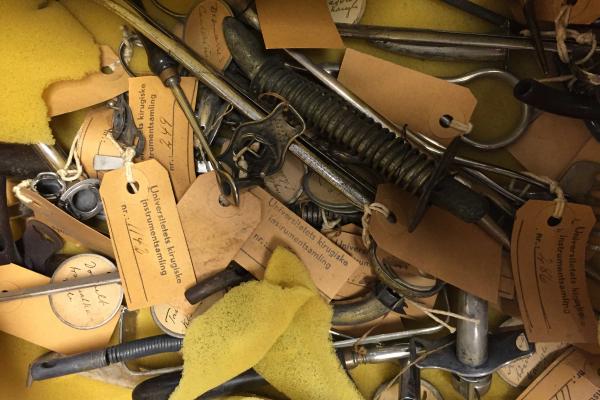
Reflection of the World
Seyed Mohammad Sadegh Mousavi
I used to live and study in Italy, as a result my family came to Italy in Summer 2015 and we went to Florence (Firenze). I took this photo when I was in the Lungarno Generale Diaz St. and in front of Museo Galileo which is very close to the Ponte Vecchio Bridge. There is no effect and filter in this photo. If we believe that the creation of the world was based on the order and the balance, then this photo indicates the reflection of the world very well.
Location of photograph:
Florence, Italy
Affiliation:
PhD Student, Civil Engineering
Submission Year:
2017-18

3D printed Al alloy
Hong Qin
The un-uniform cells are aluminum grains. Aluminum grains grow eptaxially towards to the heat flow direction forming fan shaped melt pools during selective laser melting (SLM) process. Half of the grains in red indicate a preferential growth along the laser beam direction due to directional solidification. The grains in blue and green are those located at the melt pool boundaries or where the direction of heat flow with a deviation from the laser beam direction. Fine equiaxed grains nucleated at the melt pool boundary because of the high solidification rate. These complex grains comprise a beautiful fan shaped microstructure of 3D printed aluminum.
Location of photograph:
Reactor Materials Testing Laboratory, Queen's University
Affiliation:
Post-Doctoral Fellow, Mechanical and Materials Engineering
Submission Year:
2017-18

Colours in the lab
Chúk Odenigbo
I am currently researching a more sensitive analytical method to detect a cancer-causing compound that features commonly in certain workplaces with the aim of creating industry exposure standards specific to this compound. We are using human urine from people who have been occupationally exposed. This picture shows the urine of each worker concentrated, cleaned out to reduce impurities, and dissolved in methanol, which allows for really beautiful red-orange colours.
Location of photograph:
Montreal, Quebec
Affiliation:
Alumni, School of Environmental Studies
Submission Year:
2017-18

Measuring the Invisible Wake of a 500 million-year-old Swimmer
David Rival
With this perspective we see the tail-fin model of Anomalocaris Canadensis, a 500 million-year-old predator from the Burgess Shale, as it passes through the high-speed laser sheet. Not visible on either side are high-speed cameras that capture the motion of millions of tiny silver-coated, hollow-glass spheres that track the flow. By tracking the motion of these tiny spheres we reconstruct the otherwise invisible wake of this ancient swimmer. This fin shape is unique from that period but may serve as a good model for high-performance aerodynamic control surfaces today.
Location of photograph:
OTTER lab, Queen's University
Affiliation:
Faculty, Mechanical and Materials Engineering
Submission Year:
2017-18

Pushing Limits
Madison Robertson
Research can be hard, exhausting even. It can push us to our limits. Mike Del Giudice is working hard on the VO2max test, which gives researchers insight into the health and wellness of participants. Whether you are trying to establish baseline characteristics of an individual, or monitor their changes in cardio respiratory fitness over the course of an intervention, VO2max testing is the gold standard of fitness testing in the field of exercise physiology.
Location of photograph:
School of Kinesiology and Health Studies, Queen's University
Affiliation:
Graduate Student, Kinesiology and Health Studies
Submission Year:
2017-18
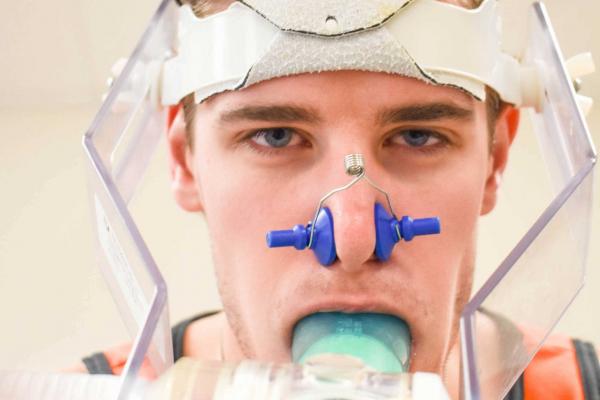
Art Meets Science Under Polarising Microscopy
Danesh Roudini
Liquid crystals have been commercially important for several decades, especially for applications in electronic displays and TV screens. They can exhibit well-known liquid crystalline mesophases in which the molecules are very responsive to applied electric or magnetic fields. When studied under polarising microscopy they can produce artistic textures, which exhibits the beauty and fascination of liquid crystals.
Location of photograph:
Kingston University, UK
Affiliation:
Faculty, Bader International Study Centre - BISC
Submission Year:
2017-18

Cormorant Fishing on Erhai Lake, China
John Smol
As part of our global program determining how lake ecosystems are changing in response to natural and human stressors, we have been visiting lakes around the world. One of the three major lakes in the Yunnan area of China is Erhai Lake, a high elevation fault lake, which is also known for its fishers who use trained cormorants to catch fish. Here you see a fisherman retrieving a fish caught by one of his birds.
Location of photograph:
Erhai Lake, Dali, China
Affiliation:
Faculty, Biology
Submission Year:
2017-18
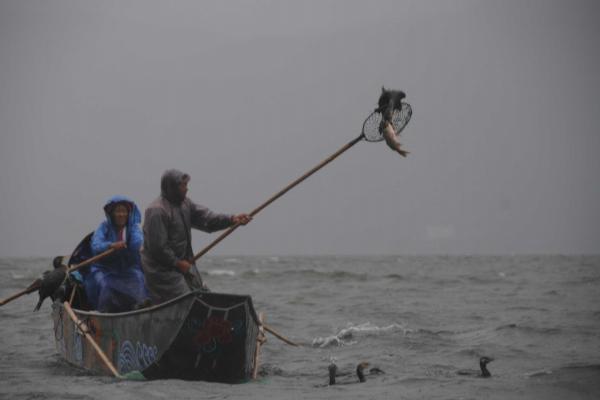
Coral Reef in a Pyrex Flask
Marshall Timmermans
Pseudoalteromonas bacteria are expert chemists that often live symbiotically with corals, sponges, and other ocean inhabitants. They will pump out dozens bioactive molecules to protect themselves and their hosts in exchange for shelter from the harsh conditions of the open ocean. We are studying Pseudoalteromonas to discover new antibiotics and other medicinal natural products. Here we see Pseudoalteromonas piscicida growing on cotton balls in a liquid medium. Much like coral, the balls allow the bacteria to attach to a solid surface and stimulate the production of very interesting natural products, such as the vibrant orange pigment seen in this photo.
Location of photograph:
Chernoff Hall, Queen's University
Affiliation:
PhD Student, Chemistry
Submission Year:
2017-18

DEAP Dreams
Connor Stone
During my Undergraduate and Master’s program I was heavily involved in the construction and analysis for DEAP-3600 (dark matter experiment). Featured is the detector nearly completed construction. The copper cylinders conduct heat to keep the light sensors warm, as the liquid argon is around -200 Celsius! Between the copper cylinders are white plastic blocks that are insulation and shielding from background radiation that might masquerade as dark matter. The three stylized images are generated using a neural network that takes a style from another painting. The most recognizable one is in the style of Van Gogh’s Starry Night.
Location of photograph:
SNOLAB, Sudbury ON
Affiliation:
PhD Student, Physics, Engineering Physics and Astronomy
Submission Year:
2017-18

Home Sweet Home
Zoe Walter
Across the animal kingdom, mothers must raise offspring in the face of significant challenges, including limited resources, predation, and disease. A staggering 90% of the red-winged blackbird population of QUBS carries a chronic infection of avian malaria, but the effects of this disease on mothers and their offspring is not well understood. An innovative pilot study by Dr. Bonier’s lab medicated wild moms with antimalarial medication and raised their young in captivity, to elucidate the nature of maternal infection status on offspring fitness. Here, an exhausted hatchling takes a well-deserved rest after successfully breaking free of its egg.
Location of photograph:
Biosciences Complex, Queen's University
Affiliation:
Undergraduate Student, Biology
Submission Year:
2017-18

(re)Constructing Nicosia’s Past and Present
Samantha Twietmeyer
Taken while conducting field research on the peace negotiations in Cyprus, Summer 2017. The mural, by local artist Farhad O’Neil, sits in an area undergoing renovation near the UN-patrolled “Green Line” vacated after the 1970s when the threat of conflict drove many Greek Cypriots out of the inner city. Titled “Constructing the Past,” it features the ubiquitous Venetian walls of Nicosia’s old city, the arrow-shaped gates interspersed with representations of the civilizations and peoples who have contributed to the architecture and culture. Both the Greek and the Ottoman heritages are represented and while the image features the dividing line, the central circle is undivided, signifying both a historical and future unity.
Location of photograph:
Thisseos St, Nicosia, Cyprus
Affiliation:
PhD Student, Political Studies
Submission Year:
2017-18

Love to Eat Oil
Saeed Rismani Yazdi
Oil spills are a significant threat to marine wildlife and human health. Nature has evolved an effective way to rectify this problem using indigenous bacteria to clean up the oil contaminants. My research focuses on studying the microscale interaction of bacteria with oil droplets to better understand the mechanisms of oil degradation by the bacteria. The picture shows oil-degrading bacteria (gray) finding an oil droplet (orange), forming biofilms around it (green), and eventually breaking it down into harmless compounds.
Location of photograph:
Queen's University
Affiliation:
PhD Student, Chemical Engineering
Submission Year:
2017-18
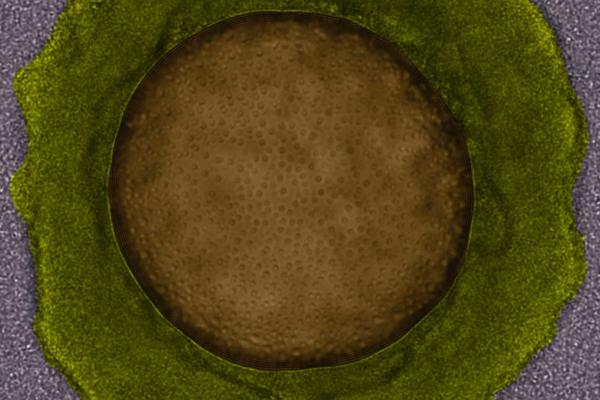
Coral
Wenxia Zhou
This photo was taken in the process of underpotential deposition of copper on gold surface. The anode is gold/silica, cathode is copper wire, and electrolyte is 0.5M CuSO4 solution. I have never expected this result. Ideally, the copper monolayer should be deposited on gold surface instead of grown copper branches with certain amount H2 gas evolving.
Location of photograph:
44°13'29.3"N 76°29'55.7"W
Affiliation:
Graduate Student, Chemistry
Submission Year:
2017-18

Twitter description:
Queen's Art of Research photo contest is an opportunity for Queen’s faculty, students, staff, and alumni to showcase their research, scho
Facebook description:
Queen's Art of Research photo contest is an opportunity for Queen’s faculty, students, staff, and alumni to showcase their research, scholarly, and artistic work.

![[Art of Research photo by Fei Chen]](https://www.queensu.ca/research/sites/all/modules/contrib/lazyloader/image_placeholder.gif)